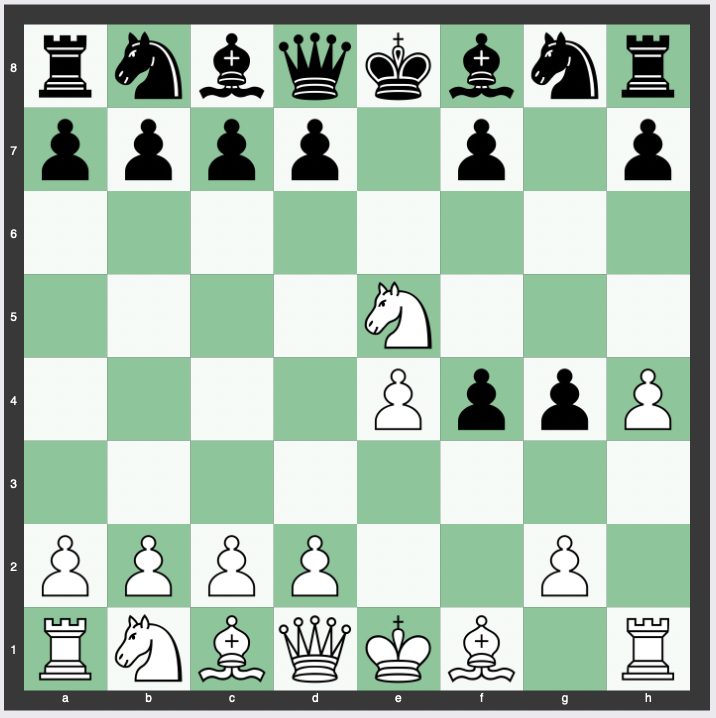In chess, the Kieseritzky Gambit is a fascinating opening in the King’s Gambit.
It commences with the moves:
- e4 e5
- f4 exf4
- Nf3 g5
- h4 g4
- Ne5

Upon Black’s endeavor to retain the sacrificed pawn with 3…g5, White responds by instantly undermining the pawn chain.
This Gambit is one of the leading lines of the King’s Gambit following 3…g5.
Despite its long history, the overall assessment of this Gambit remains somewhat ambiguous, though roughly equal.
The Kieseritzky Gambit is classified under the code C39 in the Encyclopedia of Chess Openings.
History of the Kieseritzky Gambit
The Kieseritzky Gambit has a storied history, with its roots tracing back to the late 16th century.
Polerio was the first to describe this opening. Following Polerio, Greco included a game featuring this opening in his 1620 collection.
Renowned chess figures like Salvio (1604) and Philidor (1749) also analyzed this opening.
In the first edition of the Handbuch published in 1843, 5.Ne5 was explored under the heading of the Allgaier Gambit.
However, the editors observed that Kieseritzky had contributed significantly to the theory of 5.Ne5.
They endorsed it as superior to 5.Ng5, a perspective echoed by almost all subsequent analysts.
In the second edition of the Handbuch released in 1852, the chapter was titled “Allgaier and Kieseritzky’s Gambit”.
Eventually, the term “Kieseritzky Gambit” gained widespread acceptance for the 5.Ne5 move, while the “Allgaier Gambit” was used exclusively for the 5.Ng5 move.
Main Line of the Kieseritzky Gambit
The main line of the Kieseritzky Gambit continues as follows:
5…Nf6 6.Bc4
Both the bishop on c4 and the knight on e5 target the pawn on f7.
However, if Black neglects to safeguard the pawn, the threat is generally Bxf7+ rather than Nxf7.
The move 6.d4 has also been attempted, though it is considered by some to be inferior to 6.Bc4.
6…d5 7.exd5 Bd6
Alternatively, the other principal move is 7…Bg7.
Evaluation of the Kieseritzky Gambit
The Kieseritzky Gambit is generally evaluated at around -0.35 to -0.65 for white.
Continuation lines might include:
5… Nf6
5… Nf6 6. Nxg4 Nc6 7. d4 d5 8. Nxf6+ Qxf6 9. Nc3 Bb4 10. Bb5 Rg8 11. exd5 Bg4 12. Be2 Bf5 13. O-O Qxd4+ 14. Kh1 Bxc3 15. bxc3
5… Nf6 6. Nxg4 Nc6 7. Nc3 Nd4 8. Nxf6+ Qxf6 9. d3 c6 10. Ne2 Ne6 11. Qd2 d5 12. Nxf4 dxe4 13. dxe4 Rg8 14. Qc3 Qxc3+ 15. bxc3 Bg7 16. Kf2 Nc5 17. Bd3 Bxc3 18. Rb1 Bg4
5… Nf6 6. Nxg4 Nc6 7. d4 d5 8. Nxf6+ Qxf6 9. Nc3 Bb4 10. Bb5 Rg8 11. exd5 Bg4 12. Bxc6+ bxc6 13. Qd3 Bf5 14. Qe2+ Qe7 15. O-O Qxe2 16. Nxe2
5… d6
5… d6 6. Nxg4 Nc6 7. Nf2 Nf6 8. d4 Bh6 9. Be2 d5 10. Nc3 dxe4 11. d5 Nb4 12. a3 Nbxd5 13. Nfxe4 Nxe4 14. Qxd5 Qxd5 15. Nxd5 Ng3
5… d6 6. Nxg4 Be7 7. d4 Bxh4+ 8. Nf2 Bg3 9. Qf3 Qg5 10. Nc3 Nf6 11. Bd3 Rg8 12. Kf1 Nc6 13. Ne2 Qg7 14. Bxf4 Bxf2 15. Qxf2 Ng4 16. Qg1
5… d6 6. Nxg4 Be7 7. d4 Bxh4+ 8. Nf2 Qg5 9. Qf3 Bg3 10. Nc3 Nf6 11. Bd3 Rg8 12. Ne2 Bg4 13. Bxf4 Bxf3 14. Bxg5 Bxe2 15. Bxf6 Bxd3 16. cxd3 Nd7 17. Bh4 Bxh4 18. Rxh4 Rxg2 19. Kf1
Rice Gambit is another continuation of the Kieseritzky Gambit.
Kieseritzky Gambit | King’s Gambit Opening Theory
Conclusion
The Kieseritzky Gambit, with its rich history and strategic depth, offers an engaging variation in the King’s Gambit.
Despite the inherent ambiguity in its evaluation, the gambit continues to inspire a multitude of chess players, showcasing the beauty and complexity of the game.
Its origins and development provide a window into the evolving thought processes of chess players throughout the centuries.


